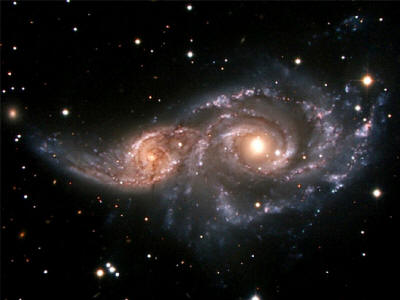|

by Stephen Smith
October 31, 2011
from
Thunderbolts Website
|
Winds and shockwaves are
often used to describe phenomena in the cosmos because
plasma behaves in unfamiliar ways. |

"Merging
galaxies" NGC 2207 and IC 2163.
Credit: ESO
According to a
recent press release, The European
Space Agency’s
orbiting telescope Herschel has observed “molecular
gas gusting at high velocities” from galaxies (below image) that appear to be
merging.
In some instances, the gas is being
driven to velocities exceeding 1000 kilometers per second. Traveling
at that speed, the United States is about fives seconds across from
coast to coast.
As the announcement goes on to state, “powerful, storm-like
processes” are taking place.

Artist's impression
of an Ultra-Luminous InfraRed Galaxy (ULIRG)
with outflows of
molecular gas.
These storms are said to be initiated by
the black holes within each galaxy as the two come together.
Another
theory is that supernova explosions take place that are sufficient
to blow away almost the entire volume of gas in a galaxy. Star
formation, with its assumed attendant high frequency radiation,
creating the blasts of galactic energy is another.
Since the idea that electricity flows through the Universe is
commonly met with resistance by today’s consensus, its influence and
attributes are unseen. It has long been said that “seeing is
believing.” However, it should not be surprising that “believing is
seeing” appears to be more apt. When there is no inner experience,
outer realities can often remain invisible.
From gamma rays down through X-rays and extreme ultraviolet,
conventional theories have relied on gravity and acceleration for
radiation to be produced in space.
Compressing hydrogen gas and dust is
supposed to create enough transfer of momentum that the gas reaches
million degree temperatures. It is the high temperature of the gas
that is supposed to make it glow so brightly.
For example, the
CHANDRA X-ray Telescope found eruptions of charged
material pouring out of the Crab Nebula, emitting X-rays as they go.
In another
announcement, astronomers reported
that two giant stars in Eta Carinae were blowing off “intense
winds.”
The winds are so powerful that the
collision of the wave fronts is thought to be generating X-rays
where the shells intersect.
All of these effects are supposed to be due to kinetic shock, even
though the researchers acknowledge that the observed “wind” is
ionized particles. Despite that understanding, researchers persist
in the use of “billiard ball physics”:
as electrons bounce back and
forth in the magnetic fields they accelerate until they impact
low-frequency photons, imparting so much energy that they become
X-rays.
From
the Electric Universe perspective, those magnetic fields do
accelerate electrons, but since the electrons spiral in the field,
they emit synchrotron radiation. To the detectors observing stars,
synchrotron radiation can be in the form of X-rays or gamma-rays.
Electric currents surge out along galactic spin axes, forming double
layers that can sometimes be seen as radio or X-ray “lobes.” The
currents spread out around the galactic circumference, flowing back
to the core along the spiral arms. All the elements in a galactic
circuit radiate energy. That energetic radiance shows that they are
powered by larger circuits.
Galaxies occur in strings, and the
extent of the larger circuits may be traced by radio telescopes from
their polarized radio “noise.”
It seems apparent that we will never be
able to observe them, since they are far too large and diffuse.
Plasma’s behavior is governed by those circuits. Double layers with
large potential voltages between them often exist. The electric
forces in double layer filaments can be much stronger than gravity.
Those filaments can also have different temperatures or densities.
Double layers broadcast radio waves over a wide range of
frequencies. They can sort galactic gas and dust and then condense
it.
Most significant to the ESA bulletin,
they can accelerate charged particles to cosmic ray energies.
This vision of the cosmos sees various components coupled to and
driven by circuits at ever larger scales. Electrons and other
charged particles accelerating through intense electric fields
radiate “shouts” of energy in many bandwidths.
The power of those currents can sweep up
neutral gas and dust as they move through a galaxy.
|


